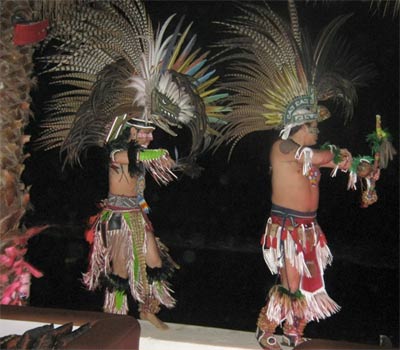A Manual
Here is the way the Colorado Ski Resorts “found a beautiful way to heal and honor the past and start a new beginning with their local tribes,” in the words to Telluride pioneer/owner Ron Allred. As a result, we found ourselves creating a bridge between our cultures, being blessed with an abundance of snow and through the friendships, solving some long standing environmental challenges almost overnight. Pictures of these events can be seen here on our website (www.nativevoices.org). It includes some History, the NVF Board, Photo galleries, Press, Reconciliation Reports, Marketing and 5 minute promo of Colorado’s pioneering documentary.
Since every ski area and tribe has its own unique story and resources, the enclosed is merely a guideline for rewriting the Native history of your region. As a visionary, you will be doing something that generations of your children will be proud of. This basic formula could also work for any sport with any town or city and its local tribe(s):
—To understand the Native perspective of what happened in our pioneering days, a point of view not taught in our schools, ideally do some research on your local history, as well as the philosophy and contributions of the First Americans. Click on to the “MVP’s of the Millennium” button for a quick perspective of their amazing contributions to the US and world.
—Recommended reading by Native Americans include: “The Indian Givers,” “The Toughest Indian Alive” by Sherman Alexie, “Exiled in the Land of the Free,” edited by Oren Lyons, “The Hotevilla Book” or “The Hopi Survival Kit,” “Black Elk Speaks”(Lakota-Sioux), “People of the Shining Mountains” by Charles Marsh (Colorado Utes). Watch for the Emmy award winning “Utes Must Go” that’s part of the series on “How the West Was Lost,” a TV documentary by Ute leaders, and Kevin Costner’s “500 Nations,” and ask your tribes which books they recommend. The Utes gave the TelSki owner a copy of their video history.
–Contact your local or regional tribes through their tribal leaders,education or cultural preservation offices or community centers. Some newspapers or nearby universities who have Native Studies Course, may have historic information and contacts. Some churches, who have respectful, supportive relationships with the reservations, may be helpful
–At the same time ask for the name(s) of the big-hearted unity leader(s) of your local tribe. In Colorado I found the Unity leader of the Utes, Alden Naranjo, who bacame my co-founder of Native American Olympic Team Foundation. For my home state of Vermont, I called Dartmouth College, founded with funds raised by Natives Americans, for advice and found an inspiring Vermont Abenaki representative, Wolfsong, whom I invited to our Reunion of Champions event at Pico. Everyone loved Wolfsong so much, that our coach, Joe Jone, who put us on the road to the Olympics, shared, “I’m part Abenaki too!”) After doing your homework, contact this person and mention your sincere interest in starting a healing and new beginning between your cultures, as the Utes said, “for the benefit of all the children.” Refer him/her to our website for background. And if they would like to start a new beginning, how they would like to do it. (The Ute leaders wanted a “Celebration ofunity on behalf of all our children” during a ski weekend. Many town Council’s like Aspen and Steamboat, created beautiful memorials to their band of the Ute tribe.)
–Talk to your ski community leades – to find out who are sympathetic, compassionate and excited about leading a new beginning with your local tribe.
–Spend some time getting to know the Native leader(s) and develop a relationship, inviting them to ski, visit your home and ideally visiting their reservation or home if they ask you. Then invite them to some fun activity (like skiing, boarding…), ideally with some of their kids, or share a meal. (Most Natives are very kids and extended family oriented like we used to be before 1946 when the men came back from WWII and started leaving the farms for the cities.
–Enjoy attending pow wows, sporting events, princess pageants, Bear Dances (in Colorado), education conferences… to get to know more tribal members and have fun participating in this learning process. On a rare occasion along the way, you might have a cultural misunderstanding and feeling may be hurt. You may need patience (a form of love) adjusting to cultural differences, like “Indian time.”
–Find a balance between Indian and Corporate Time, though some are punctual. If you can’t handle a little of our ancestors’ medicine of 400 years, this project is not for you. Any inconvenience is a small price for helping “create joyful unity through sports to heal Mother Earth for our children,” (NVF’s Mission and hopefully yours), and priceless in terms of snowblessings. In the process you’ll discover a fascinating world of self-sustaining spiritual wisdom in your backyard, that we once knew. And you may also find the best friends of your life.
–Invite the Native leader(s), perhaps with cultural presentations, to speak at your Rotary Club, school, Town meeting, Winterskol Parade, like Aspen… Perhaps they could bring a video to share (as the Utes did). A per dium or transportation is appropriate.
–At the beginning of the ski season invite a few tribal representatives and recreation directors, especially the ones who ski, to come up for a day or weekend to learn the lay of the land – where to get tickets, lessons and equipment, and who to work with.
–Exchanging gifts is always a nice, traditional touch.
HISTORIC GIFTS BY SKI AREAS
and Colorado Community TLC
Based on what worked in Colorado, to each of the 100 ski areas across America wishing to participate in leading this historic Salute To America’s First Caretakers, we recommend providing 100 weekend or 200 weekday tickets, as well as beginner lessons and rental equipment as needed each season – or whatever you can afford. Then when the ski area hosts an historic welcoming home celebration, whenever its convenient for both sides, Native leaders and dancers will have something to truly sing & dance about!
If you are putting on a Native Ski Celebration the ski areas usually give an additional 25 weekend passes to tribal groups (including lessons, equipment and housing), and in the spirit of starting a new beginning, the tribe(s) share a cultural/dance performance. . . A show costs approximately $5,000 – with participation by 4-18 singers, dancers and drummers of all ages. In terms of tourism, snow & rain blessings and the restoration of Mother Earth, it’s priceless. About 35 tribal members come, leaders, elders who come to watch, dancers who often ski as well as inspiring tiny tott dancers. After the ceremony and some skiing, most towns invite them to some kind of a getting-to-know you community feast, or party. In Telluride the dancing and blessings, as well as Native Rock Bands, were so popular that they asked us to open the National and World Snowboard Championships. The kids loved it so much that they chanted the name of the medicine man who did the protection blessing two years in a row. On such occasions, the performers are also paid a bonus. (The Tribes were the “No. 1 draw of the Salt Lake Olympics,” according to the SLC Organizing Committee.
NATIVE SKI/CEREMONY NEEDS:
–The celebrations are usually held around (warm) high noon on a snow-removed spot at the base of the slopes, even though Natives winterize their regalia. (Some substitute sneakers for moccasins.)
–Ideally they prefer a 15×20 foot area at the base of the slopes, or lodge deck, that’s been shoveled earlier and had a chance to dry.
–Ask if the Native performers have sound systems, otherwise provide one.
—Changing room – ski school locker rooms close to the performance work well.
–Though we’ve been blessed by the Great Spirit with good weather for 9 years of ceremonies, you need a backup space in case the weather closes in, as Native won’t dance in snow or rain for fear of damaging their sacred regalia.
—Collect gloves, hats, goggles and sunglasses from the lost and founds and get accessory donations from the ski school to have on hand for those who forgot or didn’t know. Two Zuni kids proved that Native Americans, like Anglos, do need sunglasses.
–We recommend that Ski Shop personel give new skiers skis no longer than chest high, and mention that their toes touch the end of their boots before buckling (not fit like moccasins!)
—Suggest they dress warmly in layers, including long johns – jeans can get wet.
–Hotels, families, restaurants, pizza parlors and supermarkets, including in South Dakota, donate their hospitality to make the tribes feel welcome.
–Contact NVF if you would like to bring in members of the Native American Olympic Ski Team, captained by Olympic Silver Medallist Billy Kidd (Abenaki), with Stew Young (Tulalip speedskier), Gene Tabagan (Tlinkit-Cherokee x-treme skiers, or Olympic Ice Dancer Naomi Lang (featured on http://www.nativevoices.org/.
–Free Skiwear- Help tribal leaders can get high quality used gear from ski shops, ski swaps, and thrift shops.
–We highly recommend including Indian children in your school programs, as many resorts have graciously done, led by Taos, Mammoth… Telluride’s French Ski School Director Annie Savath started inviting children from the Navajo Schools to Telluride 18 years ago. The skiing is magically helping turn around their huge school drop out rate. Navajo Prep’s Student Council organized their whole Telluride ski and dance weekend themselves.
–The ski shops often share equipment needs to lighten the impact to supplement the ski area ticket donations. While ski instructors and Native kids fall in love with each other – the kids are appreciative, natural athletes, and laugh when they fall – few after the first day take group lessons. Volunteers enjoy skiing with them after they learn the basics.
–If there is no memorial to honor the first inhabitants of your valley or region, this would be a beautiful time to plan one. Steamboat Town Council created a Ute Sanctuary next to their Yampa River and commissioned Robert Colorow, a renowned artist and descendent of the great Chief, to design a symbolic sculpture. The Town of Ophir created a moving plaque on a huge rock and planted trees around it. People from the region (next to Telluride) at the ceremony with Ute leaders and children were asked to embody their hopes and dreams in a stone that they buried underneath the boulder.
NEXT STEP:
Contact NVF if you would like help or guidance starting a program or hosting an event. We are here to assist you at:
970 4040687. The key to a real healing is each of us giving something back.
NVF is a 501C3 Colorado not-for-profit organization No. 84-1507336. We greatly appreciate any funds that you, your ski resort, friends, foundations or sponsors can share to help realize these dreams for Native Americans and to “strengthen the future of skiing and help keep Winters Cool.” –Michael Berry, President of the National Ski Areas Association.
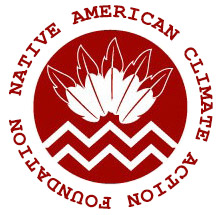

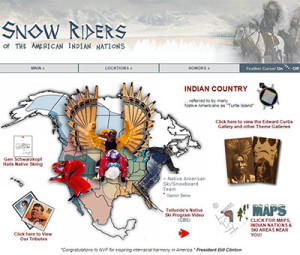
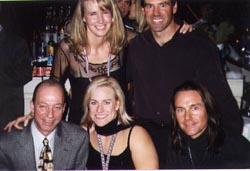 Olympians honoring Native American Olympic Team Foundation at Chicago Ski Ball in November.
Olympians honoring Native American Olympic Team Foundation at Chicago Ski Ball in November.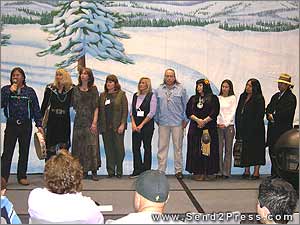 Photo caption: Shoshone Benny LeBeau, leader of Big Bear Medicine Wheel Snow Ceremony, thanked by skiers at LA Ski Dazzle Show, next to Olympic host Suzy Chaffee with Gina Weiss and seven of the 200 diverse "miracle" participants - Black Elk Prophesy.
Photo caption: Shoshone Benny LeBeau, leader of Big Bear Medicine Wheel Snow Ceremony, thanked by skiers at LA Ski Dazzle Show, next to Olympic host Suzy Chaffee with Gina Weiss and seven of the 200 diverse "miracle" participants - Black Elk Prophesy.